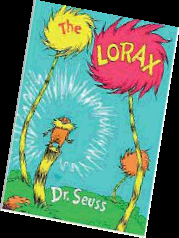SEJournal Online is the digital news magazine of the Society of Environmental Journalists. Learn more about SEJournal Online, including submission, subscription and advertising information.

Feature
By MICHELLE NIJHUIS
“The Lorax speaks for the trees.” But do e-beat writers too often reach for that bad-news narrative?
There’s a lot of genuine tragedy on the environmental beat, and it doesn’t take a partisan to see it. There’s not a whole lot to like about water pollution, or crop failures, or mass extinction. But I wonder if environmental journalists, steeped as we are in bad news, reach too quickly for the Lorax narrative. You know how it goes: The Lorax speaks for the trees, the rest of us keep buying the needs, and for hope all we get is the Once-ler’s last seed.
Are there other ways to tell environmental stories? With Christopher Booker’s Seven Basic Plots as a field guide, I’ve been searching for examples of environmental journalism with other-than-tragic narratives — archetypal frameworks that still fit the facts, but startle the reader out of his or her mournful stupor. I’ve found some good ones, and I’d love to hear about more.
The Overcoming the Monster narrative often shows up in invasive-species stories. For one recent and hilarious example, check out this [July 26, 2010] story from Esquire about Argentine ants. (“They’re not in your underwear by accident. They’re nation-building.”) For a different kind of struggle against a very different kind of monster, listen to “Just Another Fish Story,” a gem of a radio piece about a small Maine town’s attempt to cope with a beached whale.
A wonderful example of the Rags to Riches narrative at work in an environmental story is “Wild Eyes,” a Radiolab piece about big-cat conservationist Alan Rabinowitz and his lifelong connection with animals. (Rabinowitz told the story himself on the Mothstage at Man and Beast.)
The Quest narrative is common in science stories: Scientist sets out on a journey of discovery, faces obstacles, and ultimately overcomes them (or not). I’ve been on a John McPhee binge lately, so I’ll cite “Atchafalaya,” the colossal New Yorker story that’s also the first chapter of his book The Control of Nature. Here, the earnest but short-sighted hero is the U.S. Army Corps of Engineers, and its quest — to keep the wandering Mississippi on its current course — is surely doomed.
The Voyage and Return narrative is similar to the Quest, except that the hero returns home with the wisdom earned from his or her adventure. For an unusual example, read Edwin Dobb’s personal story about his love of open-water swimming, and what he’s learned about wilderness from his progressively longer, colder swims. It can be found here.
Finding the Comedy narrative in environmental journalism isn’t as tough as it sounds: as psychologist John Fraser points out environmental stories are full of comedies of errors in his story on Grist. (The problem is that most are missing their happy endings.) Earlier this year, I wrote an appreciation of Ian Frazier’s genius story “Hogs Wild,” in which humans and feral hogs play the comedic leads in an essentially tragic tale.
Environmental journalists occasionally get to dig out the Rebirth narrative, though we often find its dark side. I recently edited Brad Tyer’s poignant High Country News story about Opportunity, Montana, a small town destined to be the victim of a much-celebrated Superfund cleanup. The Rebirth story of the cleanup has been told many times; Tyer flipped the archetype and found what lay forgotten underneath.
Last but not least is our old friend Tragedy. I’ll spare you countless possible examples and leave you with one especially memorable story: “Tuna’s End,” an excerpt from Paul Greenberg’s book Four Fish. “Tuna then are both a real thing and a metaphor,” Greenberg writes. “Literally they are one of the last big public supplies of wild fish left in the world. Metaphorically they are the terminus of an idea: that the ocean is an endless resource where new fish can always be found.”
Sometimes, the Lorax is just the fastest way to the truth.
Editor’s note: This story was originally posted on the science and science writing blog, The Last Word On Nothing, which touts “Science: clear, crafty, and delivered to your door.” Interesting comments followed the post including a couple suggestions of other narrative forms — David v. Goliath or, to use more modern terms Erin Brockovich and, finally, Sheep in Wolf’s Clothing.
Michelle Nijhuis lives in western Colorado, between the foothills of the Rockies and the redrock canyons of southeastern Utah. A lapsed biologist, she specializes in long-form stories. In 2011, as an Alicia Patterson Foundation fellow, she reported on radical measures to conserve endangered species. She’s also a longtime editor of High Country News.
* From the quarterly newsletter SEJournal, Winter 2011-12. Each new issue of SEJournal is available to members and subscribers only; find subscription information here or learn how to join SEJ. Past issues are archived for the public here.













 Advertisement
Advertisement 



